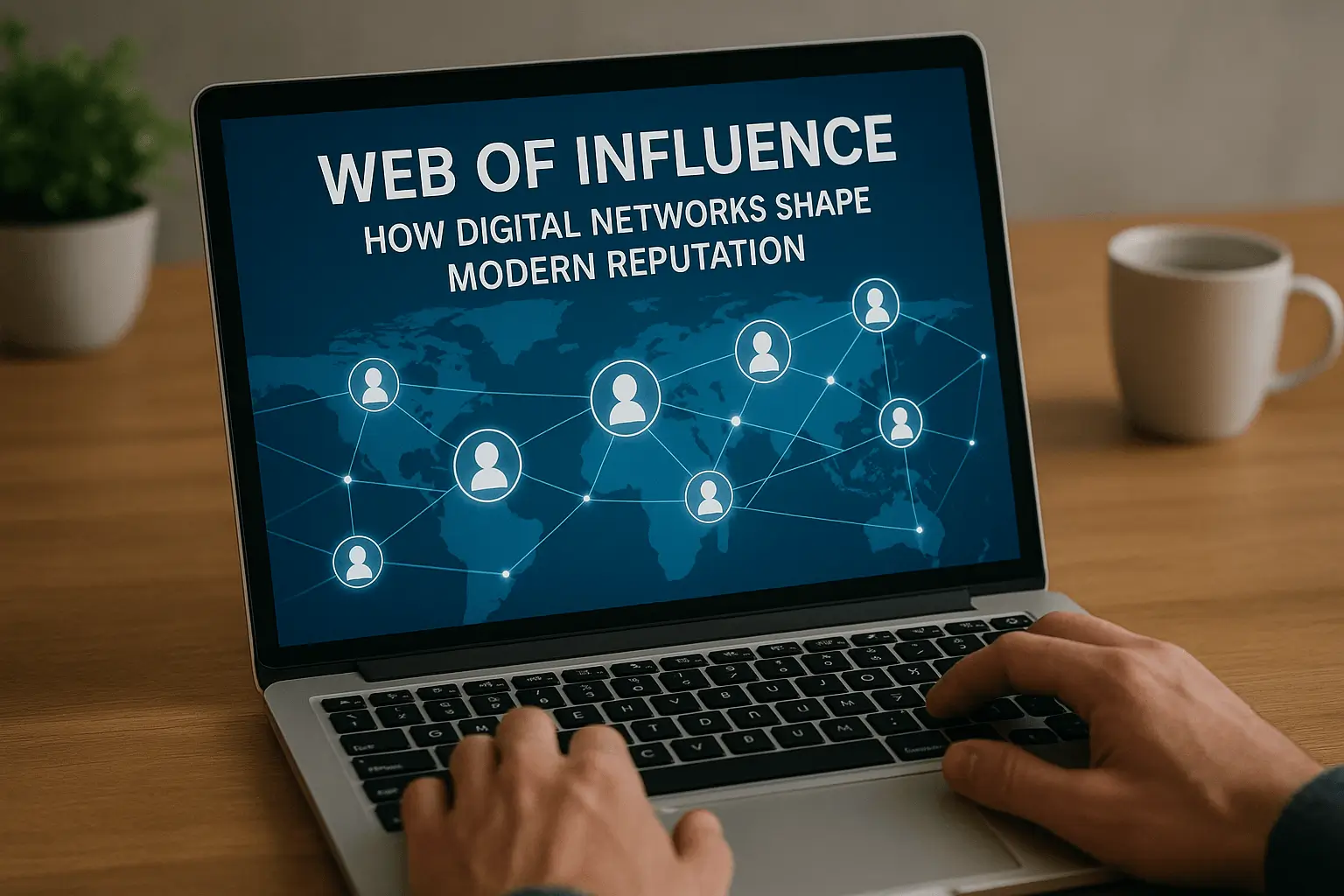
In the digital age, reputation isn’t built in isolation—it’s woven through intricate webs of influence that span platforms, communities, and connections. With 70% of technology company value deriving from network effects and influence networks determining everything from viral content to career opportunities, understanding these digital webs has become essential for reputation management. Yet most approach online reputation as if it exists in a vacuum, missing the exponential power of networked influence.
The mathematics are staggering while traditional thinking assumes linear growth, digital influence follows Reed’s Law, growing at 2^N—meaning a network of 10 connections has 1,024 potential sub-groups, while 20 connections create over a million. This exponential dynamic explains why some individuals and brands achieve seemingly overnight reputation transformation while others struggle despite superior products or services.
Web Influence on Reputation
Web Influence on Reputation refers to the impact that online content, interactions, and visibility have on how individuals, brands, or organizations are perceived by the public. This influence comes from search engine results, social media activity, online reviews, news articles, blogs, and other digital content. A strong positive web presence can build trust, credibility, and customer loyalty, while negative content—such as bad reviews, unfavorable news, or viral criticism—can harm reputation and affect business or personal opportunities. In today’s digital age, reputation is often shaped more by online perception than by offline reality.
The Architecture of Digital Influence Networks
Digital influence operates through interconnected layers, each amplifying or diminishing reputation signals:
Primary Influence Nodes
Individual Influencers: From nano-influencers with 1,000 followers achieving 7.2% engagement rates to mega-influencers reaching millions, individual nodes create reputation ripples. But size doesn’t equal influence—micro-influencers generate 60% higher engagement than macro-influencers.
Platform Algorithms: These invisible influencers determine content distribution, shaping whose opinions reach which audiences. Understanding algorithmic influence patterns is crucial for reputation strategy.
Community Clusters: Tightly connected groups within larger networks wield disproportionate influence. A negative sentiment in one cluster can cascade through entire networks or remain contained, depending on cluster connectivity.
Media Entities: Traditional and digital media create influence bridges between networks, amplifying certain narratives while suppressing others.
Secondary Influence Layers
Engagement Metrics: Likes, shares, and comments create visible influence signals that algorithms and humans use to assess credibility and importance.
Cross-Platform Presence: Influence multiplies when consistent messages appear across multiple platforms, creating an omnipresence effect.
Temporal Dynamics: Timing within influence networks matters—early adoption or commentary positions create outsized influence compared to late participation.
Geographic Networks: Local influence networks often carry more weight than global ones for location-dependent reputation.
The 16 Types of Network Effects in Reputation
Drawing from NFX’s comprehensive research, reputation benefits from multiple network effect types:
Direct Network Effects
1. Peer-to-Peer Reputation Networks: Each new connection increases reputation validation opportunities. LinkedIn demonstrates this—profiles with 500+ connections receive 10x more opportunities.
2. Communication Network Reputation: Messaging platforms create reputation through association. Being in exclusive WhatsApp or Slack groups signals insider status.
3. Social Network Reputation: Traditional social platforms where reputation spreads through friend networks, amplified by platform mechanics.
Indirect Network Effects
4. Marketplace Reputation: Two-sided platforms where buyer and seller reputations intertwine. Strong ratings on one side attract quality participants on the other.
5. Platform Reputation: Developer ecosystems where contributing to popular platforms enhances individual reputation.
6. Content Network Effects: Reputation built through content that improves with user contributions—Wikipedia editors, GitHub contributors.
Data Network Effects
7. Behavioral Reputation: Platforms learning from user behavior to surface reputation signals—Google understanding expertise through search patterns.
8. Algorithmic Reputation: AI systems creating reputation scores from complex data patterns, like Klout scores or influencer rankings.
Social Network Effects
9. Bandwagon Reputation: Momentum-driven reputation where popularity breeds popularity, creating viral reputation moments.
10. Language Network Effects: Reputation within specific linguistic or cultural communities that doesn’t translate across boundaries.
Hidden Network Effects
11. Slow Network Reputation: Professional networks where reputation builds over years through repeated interactions.
12. Unfinished Network Reputation: Early participants in emerging networks gain outsized reputation benefits when networks mature.
13. Throttled Network Reputation: Exclusive networks where scarcity enhances reputation value.
14. Asymptotic Network Reputation: Networks where reputation gains plateau after reaching critical mass.
15. Expertise Network Effects: Specialized knowledge networks where reputation comes from recognized expertise.
16. Tribal Network Reputation: Identity-based networks where shared values create reputation bonds.
The Psychology of Influence Networks
Understanding how influence spreads through networks requires grasping key psychological principles:
Social Proof Amplification
The Beijing restaurant study revealed a crucial insight: labeling dishes as “most popular” increased orders by 13-20%. In digital networks, this effect multiplies exponentially. When influencers endorse products or ideas, their networks don’t just see a recommendation—they see social proof that cascades through multiple trust layers.
Authority Transfer Mechanics
Influence networks operate on authority transfer principles:
- Direct Transfer: When a respected figure endorses you, their authority partially transfers
- Network Transfer: Being connected to influential nodes increases your perceived authority
- Context Transfer: Authority in one domain can transfer to related domains through network connections
The Weak Ties Phenomenon
Counterintuitively, weak network connections often provide more reputation value than strong ones. Weak ties bridge different network clusters, allowing reputation to spread beyond echo chambers into new audiences.
Strategic Positioning Within Influence Networks
Success requires understanding where and how to position yourself within existing networks:
Structural Hole Theory
The most valuable network positions exist at “structural holes”—gaps between network clusters. Individuals or brands bridging these gaps gain:
- Information arbitrage opportunities
- First-mover advantages in cross-cluster trends
- Reputation as connectors and thought leaders
- Control over information flow between clusters
The Hub Strategy
Becoming a network hub—where multiple connections converge—creates compound reputation benefits:
- Increased visibility across network branches
- Authority through centrality
- Information advantages from multiple sources
- Network resilience through diverse connections
The Specialist Niche Approach
Deep expertise in narrow domains creates influence density that broad approaches can’t match:
- Higher engagement rates within specific communities
- Stronger authority signals to algorithms
- More valuable connections despite smaller networks
- Premium positioning opportunities
Measuring Influence Network Impact
Traditional metrics fail to capture network influence dynamics. Advanced measurement requires:
Network Analysis Metrics
Degree Centrality: Number of direct connections indicating immediate influence reach.
Betweenness Centrality: Frequency of appearing on shortest paths between other nodes, indicating bridge influence.
Eigenvector Centrality: Quality of connections mattering more than quantity—being connected to influential nodes.
Clustering Coefficient: Density of connections within your immediate network, indicating community strength.
Influence Flow Metrics
Amplification Rate: How much your content gets shared beyond immediate network.
Cascade Depth: How many network layers your influence penetrates.
Cross-Network Spread: Ability to influence across different platforms and communities.
Sentiment Propagation: How emotional tone of your content spreads through networks.
Reputation Impact Indicators
Authority Score Growth: Rate at which recognized expertise increases.
Trust Signal Accumulation: Collection of endorsements, citations, and validations.
Opportunity Generation: Tangible benefits flowing from network position.
Crisis Resilience: Network support during reputation challenges.
Building Strategic Influence Networks
Creating powerful influence networks requires systematic approaches:
The Value-First Principle
Before seeking influence, provide value:
- Share insights without expecting immediate returns
- Connect others within your network
- Amplify others’ content strategically
- Solve problems for network members
The Authentic Engagement Strategy
Genuine connections outperform transactional ones:
- Engage with content meaningfully, not superficially
- Build relationships before making requests
- Maintain consistency in interactions
- Show up during others’ important moments
The Multi-Platform Orchestration
Influence multiplies across platforms:
- Maintain consistent identity across networks
- Cross-pollinate content strategically
- Build platform-specific strategies
- Create network bridges between platforms
Navigating Influence Network Pitfalls
Understanding potential dangers helps protect reputation:
Echo Chamber Entrapment
Closed network loops can:
- Limit perspective and growth
- Create false consensus effects
- Reduce broader market influence
- Increase vulnerability to disruption
Influence Manipulation
Bad actors exploit networks through:
- Coordinated inauthentic behavior
- Bot networks creating false influence
- Astroturfing campaigns
- Influence washing through purchased connections
Network Cascade Risks
Negative events can spread rapidly:
- Crisis contagion through connected nodes
- Guilt by association effects
- Algorithmic amplification of negativity
- Cancel culture mob dynamics
Future Evolution of Influence Networks
Emerging trends will reshape influence dynamics:
AI-Mediated Influence
Machine learning will increasingly:
- Predict influence patterns before they manifest
- Optimize content for network spread
- Identify emerging influential nodes
- Automate relationship building
Decentralized Influence
Blockchain and Web3 technologies promise:
- Portable reputation across platforms
- Verified influence metrics
- Decentralized governance of networks
- Token-based influence economies
Virtual World Networks
Metaverse platforms create:
- New influence dynamics in virtual spaces
- Avatar-based reputation systems
- Cross-reality influence bridges
- Virtual goods as influence signals
Mastering Your Web of Influence
In the networked digital age, reputation isn’t just about what you do—it’s about how your actions ripple through interconnected webs of influence. Understanding and strategically building these networks transforms reputation from a passive asset to an active force multiplier.
Net Reputation Global brings sophisticated network analysis and influence building strategies to transform your digital presence. We understand that modern reputation exists within complex influence webs that require expert navigation.
Our Web of Influence Services
Network Analysis and Mapping: Comprehensive analysis of your current influence networks and strategic opportunities.
Influence Node Identification: Discover key connectors and influencers within your industry ecosystem.
Strategic Network Building: Systematic approaches to building valuable, authentic connections.
Cross-Platform Orchestration: Coordinate influence strategies across all digital platforms.
Content Amplification Strategy: Create content designed for network spread and influence building.
Influencer Partnership Management: Build and maintain relationships with key influence nodes.
Network Crisis Prevention: Monitor influence networks for potential reputation threats.
ROI Measurement: Track tangible benefits from influence network development.
Your reputation in the digital age is only as strong as your network. Let Net Reputation Global help you build influence webs that amplify your message and protect your reputation.
Let’s Build Your Digital Network Together
Your digital influence shouldn’t be left to chance. At Net Reputation Global, we understand the intricate web of connections that shape online reputation—because we’ve been mapping and optimizing them for years. We help you identify the key influencers in your industry, build meaningful digital relationships, and position yourself where it matters most. Think of us as your digital networking strategists who know which connections will actually move the needle for your reputation. You focus on running your business; we’ll make sure the right people are talking about it in the right places.
In the connected economy, your network truly is your net worth. Make sure yours is working for your reputation, not against it.


